Mass and Heat Transfer of Thermochemical Fluids in a Fractured Porous Medium
Abstract
:1. Introduction
2. Modeling Methodology
2.1. Velocity Profiles
- (1)
- Incompressible single-phase fluids;
- (2)
- Newtonian fluids while the effective viscosity is used for non-Newtonian fluids;
- (3)
- Steady-state condition;
- (4)
- Laminar flow; and
- (5)
- Leaky channels where fluids are lost from the fracture to the reservoir.
2.2. Concentration Profiles
2.3. Temperature Profiles
2.4. Fracture Domain
2.5. Model Limitations
2.6. Solution Grid Independence
3. Model Validation
4. Model Results and Analysis
4.1. Thermochemical Reaction
4.2. Sensitivity Analysis
4.2.1. Fluid Injection Temperature
4.2.2. Fluid Injection Rate
4.2.3. TC Concentrations
4.2.4. Treatment Volume
4.2.5. TCs Triggered by HCl Acid
5. Conclusions
- 1- The treatment design parameters, such as the injection rate, TCs concentration, treatment volume, and TC fluids temperature, impact both the TCs’ penetration distance and heat propagation profile.
- 2- The TC concentration is the most significant in controlling the temperature response and penetration distance of TCs. For instance, the temperature peak could be increased from 280 to 600 °F by increasing the concentration from 1 to 3 mol/L. Nevertheless, the penetration distance would be reduced significantly.
- 3- The injection rate is a significant parameter that could be used to control the TCs penetration distance where higher rates result in higher penetration.
- 4- Most of the cases showed that the TCs are consumed within a short distance from the wellbore; nevertheless, the heat of reaction propagated much longer within the fracture.
- 5- The treatment volume of TCs did not have a significant impact on the temperature magnitude but impacted the fracture volume.
- 6- Acid could be used to trigger the TC reaction, especially in acid fracturing operations. It results in a higher temperature response and higher fracture width and dissolution. The negative impact, however, would be lowering the acid penetration distance.
Author Contributions
Funding
Acknowledgments
Conflicts of Interest
Nomenclature
References
- Tariq, Z.; Mahmoud, M.; Abdulraheem, A.; Al-Nakhli, A.; Bataweel, M. An experimental study to reduce the breakdown pressure of the unconventional carbonate rock by cyclic injection of thermochemical fluids. J. Pet. Sci. Eng. 2020, 187, 106859. [Google Scholar] [CrossRef]
- Al-Nakhli, A.; Mahmoud, M.; Al-Badairy, H.; Alqam, M. Advanced study of pore structure and mechanical property change of tight sand due to thermochemical treatment. In Proceedings of the International Petroleum Technology Conference, Beijing, China, 26–28 March 2019. [Google Scholar]
- Mustafa, A.; Tariq, Z.; Abdulraheem, A.; Mahmoud, M.; Al Nakhli, A.; BaTaweel, M. Increasing stimulated reservoir volume SRV in unconventional reservoirs: microstructural and rock mechanical study. In Proceedings of the Abu Dhabi International Petroleum Exhibition & Conference, Abu Dhabi, UAE, 12–15 November 2018; Society of Petroleum Engineers: Abu Dhabi, UAE. [Google Scholar]
- Alruwaili, K.; Han, Y.; Al-nakhli, A.; Bataweel, M. Large-Scale Chemically Pulsed Fracturing Stimulation of Unconventional Reservoir Using Hybrid FEM-DEM Approach. In Proceedings of the SPE Middle East Oil and Gas Show and Conference, Manama, Bahrain, 18–21 March 2019. [Google Scholar]
- Tariq, Z.; Mahmoud, M.; Abdulraheem, A.; Al-Shehri, D.; Al-Nakhli, A.; Asad, A. An Experimental Evaluation of Thermochemical Fracturing in Layered Formations. In Proceedings of the SPE/PAPG Pakistan Section Annual Technical Symposium and Exhibition, Islamabad, Pakistan, 18–20 November 2019. [Google Scholar]
- Mahmoud, M.; Alade, O.S.; Hamdy, M.; Patil, S.; Mokheimer, E.M.A. In situ steam and nitrogen gas generation by thermochemical fluid Injection: A new approach for heavy oil recovery. Energy Convers. Manag. 2019, 202, 112203. [Google Scholar] [CrossRef]
- Moussa, T.; Mahmoud, M.; Mokheimer, E.M.A.; Al-Shehri, D.; Patil, S.; Moussa, T. Heavy Oil Recovery Using In Situ Steam Generated by Thermochemicals: A Numerical Simulation Study. J. Energy Resour. Technol. 2019, 141, 122903. [Google Scholar] [CrossRef]
- Moussa, T.; Patil, S.; Mahmoud, M. Feasibility Study of Heavy oil Recovery Using In-situ Steam Generated by Thermochemicals. In Proceedings of the SPE Western Regional Meeting, San Jose, CA, USA, 23–26 April 2019. [Google Scholar]
- Moussa, T.; Mahmoud, M.; Mokheimer, E.M.A.; Habib, M.A.; Elkatatny, S. Well-Placement Optimization in Heavy Oil Reservoirs Using a Novel Method of In Situ Steam Generation. J. Energy Resour. Technol. 2018, 141, 032906. [Google Scholar] [CrossRef]
- Babadagli, T. Technology Focus: Heavy Oil. J. Pet. Technol. 2019, 71, 68. [Google Scholar] [CrossRef]
- Vijayvargia, U.; Jamiolahmady, M.; Nakhli, A.R.; Yi, N.K. Clean-Up Efficiency of Multiple Fractured Horizontal Wells Enhanced by Reactive Chemicals in Tight Gas Homogeneous & Naturally Fractured Reservoirs. In Proceedings of the SPE Middle East Oil and Gas Show and Conference, Manama, Bahrain, 18–21 March 2019. [Google Scholar]
- Hassan, A.; Mahmoud, M.; Al-Majed, A.; Alade, O.; Al-Nakhli, A.; Bataweel, M.; Elktatany, S. Development of A New Chemical Treatment for Removing Water Blockage in Tight Reservoirs. In Proceedings of the SPE Middle East Oil and Gas Show and Conference, Manama, Bahrain, 17–19 March 2019. [Google Scholar]
- Hassan, A.; Mahmoud, M.; Al-Majed, A.; Al-Nakhli, A.; Bataweel, M.; Elktatany, S. Permanent Removal of Condensate Banking in Tight Gas Reservoirs Using Thermochemicals. In Proceedings of the SPE International Conference on Oilfield Chemistry, Galveston, TX, USA, 8–9 April 2019. [Google Scholar]
- Alade, O.; Mahmoud, M.; Al-Shehri, D.A.; Ganiyu, S.A.; Al-Nakhli, A.; Bataweel, M. Kinetics of Thermal Decomposition of Tar in the Presence of Air and Nitrogen Gas. Energy Fuels 2019, 33, 10167–10175. [Google Scholar] [CrossRef]
- Alade, O.; Hassan, A.; Al Shehri, D.; Mahmoud, M.; Nakhli, A.; Bataweel, M. Investigation into Emulsion Blockage Removal Using Thermochemical Fluid. In Proceedings of the SPE International Conference and Exhibition on Formation Damage Control, Lafayette, LA, USA, 19–21 February 2020. [Google Scholar]
- Hassan, A.; Mahmoud, M.; Al-Majed, A.; Alawi, M.B.; Elkatatny, S.; Bataweel, M.; Al-Nakhli, A. Gas condensate treatment: A critical review of materials, methods, field applications, and new solutions. J. Pet. Sci. Eng. 2019, 177, 602–613. [Google Scholar] [CrossRef]
- Gomaa, I.; Mahmoud, M. Stimulating illitic sandstone reservoirs using in-situ generated HF with the aid of thermochemicals. J. Pet. Sci. Eng. 2020, 190, 107089. [Google Scholar] [CrossRef]
- Gomaa, I.; Mahmoud, M.; Kamal, M.S. Novel Approach for Sandstone Acidizing Using in Situ-Generated Hydrofluoric Acid with the Aid of Thermochemicals. ACS Omega 2020, 5, 1188–1197. [Google Scholar] [CrossRef]
- Van Essen, V.M.; Zondag, H.A.; Gores, J.C.; Bleijendaal, L.P.J.; Bakker, M.; Schuitema, R.; Van Helden, W.G.J.; He, Z.; Rindt, C.C.M. Characterization of MgSO4 Hydrate for Thermochemical Seasonal Heat Storage. J. Sol. Energy Eng. 2009, 131, 041014. [Google Scholar] [CrossRef]
- Yoshida, N.; Hill, A.D.; Zhu, D. Comprehensive Modeling of Downhole Temperature in a Horizontal Well With Multiple Fractures. SPE J. 2018, 23, 1580–1602. [Google Scholar] [CrossRef]
- Ma, Y.; Zhang, Y.; Huang, Y.; Zhang, Y.; Hu, Z. Experimental study on flow and heat transfer characteristics of water flowing through a rock fracture induced by hydraulic fracturing for an enhanced geothermal system. Appl. Therm. Eng. 2019, 154, 433–441. [Google Scholar] [CrossRef]
- Shi, Y.; Song, X.; Li, J.; Wang, G.; Yulong, F.; Geng, L. Analysis for effects of complex fracture network geometries on heat extraction efficiency of a multilateral-well enhanced geothermal system. Appl. Therm. Eng. 2019, 159, 113828. [Google Scholar] [CrossRef]
- Settari, A.; Sullivan, R.; Hansen, C. A New Two-Dimensional Model for Acid-Fracturing Design. SPE Prod. Facil. 2001, 16, 200–209. [Google Scholar] [CrossRef]
- Romero, J.; Gu, H.; Gulrajani, S. 3D Transport in Acid-Fracturing Treatments: Theoretical Development and Consequences for Hydrocarbon Production. SPE Prod. Facil. 2001, 16, 122–130. [Google Scholar] [CrossRef]
- Oeth, C.; Hill, A.; Zhu, D. Acid Fracture Treatment Design with Three-Dimensional Simulation. In Proceedings of the SPE Hydraulic Fracturing Technology Conference, The Woodlands, TX, USA, 4–6 February 2014. [Google Scholar]
- Dejam, M. Advective-diffusive-reactive solute transport due to non-Newtonian fluid flows in a fracture surrounded by a tight porous medium. Int. J. Heat Mass Transf. 2019, 128, 1307–1321. [Google Scholar] [CrossRef]
- Aljawad, M.S.; Schwalbert, M.P.; Zhu, D.; Hill, A.D. Optimizing Acid Fracture Design in Calcite Formations: Guidelines Using a Fully Integrated Model. SPE Prod. Oper. 2020, 35, 161–177. [Google Scholar] [CrossRef]
- Al Jawad, M.; Schwalbert, M.P.; Zhu, D.; Hill, A.D. Improving acid fracture design in dolomite formations utilizing a fully integrated acid fracture model. J. Pet. Sci. Eng. 2020, 184, 106481. [Google Scholar] [CrossRef]
- Aljawad, M.S. Identifying Formation Mineralogy Composition in Acid Fracturing From Distributed Temperature Measurements. SPE Reserv. Evaluation Eng. 2020, 23, 200–211. [Google Scholar] [CrossRef]
- Berman, A.S. Laminar Flow in Channels with Porous Walls. J. Appl. Phys. 1953, 24, 1232–1235. [Google Scholar] [CrossRef]
- Alade, O.S.; Mahmoud, M.; Hassan, A.; Al-Shehri, D.; Al-Nakhli, A.; Bataweel, M.; Hasan, A. Evaluation of Kinetics and Energetics of Thermochemical Fluids for Enhanced Recovery of Heavy Oil and Liquid Condensate. Energy Fuels 2019, 33, 5538–5543. [Google Scholar] [CrossRef]
- Roberts, L.; Guin, J. A New Method for Predicting Acid Penetration Distance. Soc. Pet. Eng. J. 1975, 15, 277–286. [Google Scholar] [CrossRef]
- Schechter, R.S. Oil Well Stimulation; Prentice Hall: Bergen, NJ, USA, 1992. [Google Scholar]
- Al-Nakhli, A.R.; Sukkar, L.A.; Arukhe, J.; Mulhem, A.; Mohannad, A.; Ayub, M.; Arifin, M. In-Situ Steam Generation A New Technology Application for Heavy Oil Production. In Proceedings of the SPE Heavy Oil Conference and Exhibition, Kuwait City, Kuwait, 6–8 December 2016. [Google Scholar]
- Lee, M.; Roberts, L. Effect of Heat of Reaction on Temperature Distribution and Acid Penetration in a Fracture. Soc. Pet. Eng. J. 1980, 20, 501–507. [Google Scholar] [CrossRef]
- Settari, A. Modeling of Acid-Fracturing Treatments. SPE Prod. Facil. 1993, 8, 30–38. [Google Scholar] [CrossRef]
- Aljawad, M.S.; Schwalbert, M.P.; Mahmoud, M.; Sultan, A. Impacts of natural fractures on acid fracture design: A modeling study. Energy Rep. 2020, 6, 1073–1082. [Google Scholar] [CrossRef]
Sample Availability: Samples of the compounds are not available from the authors. |
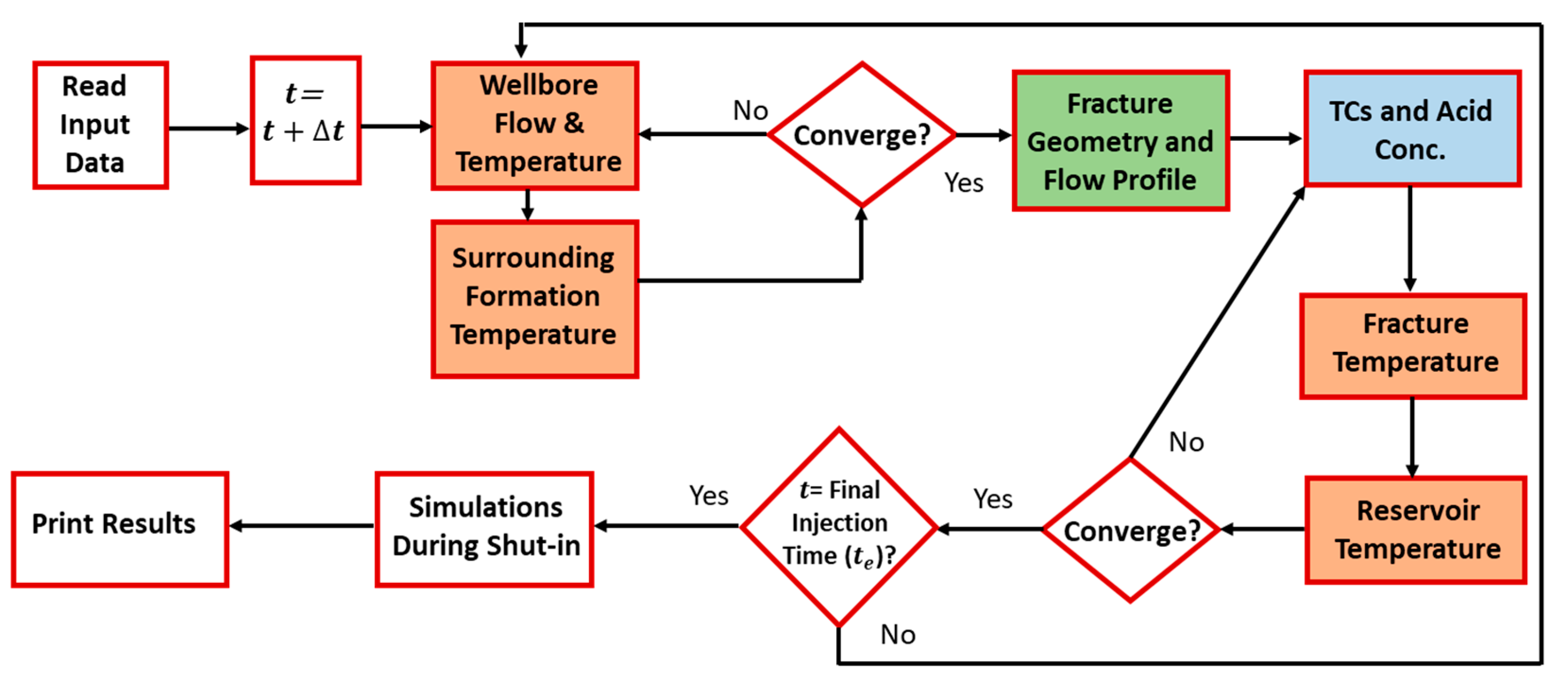

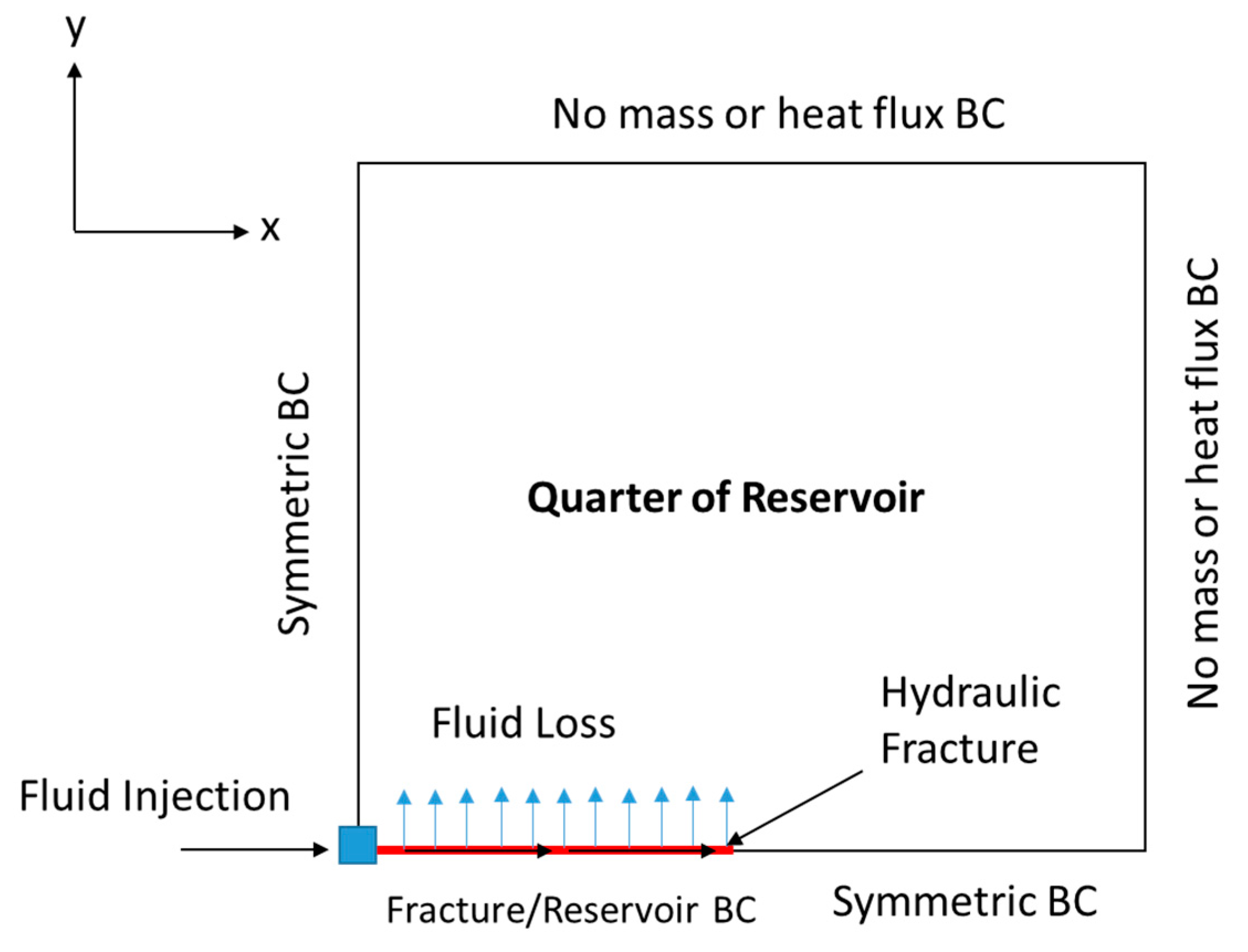
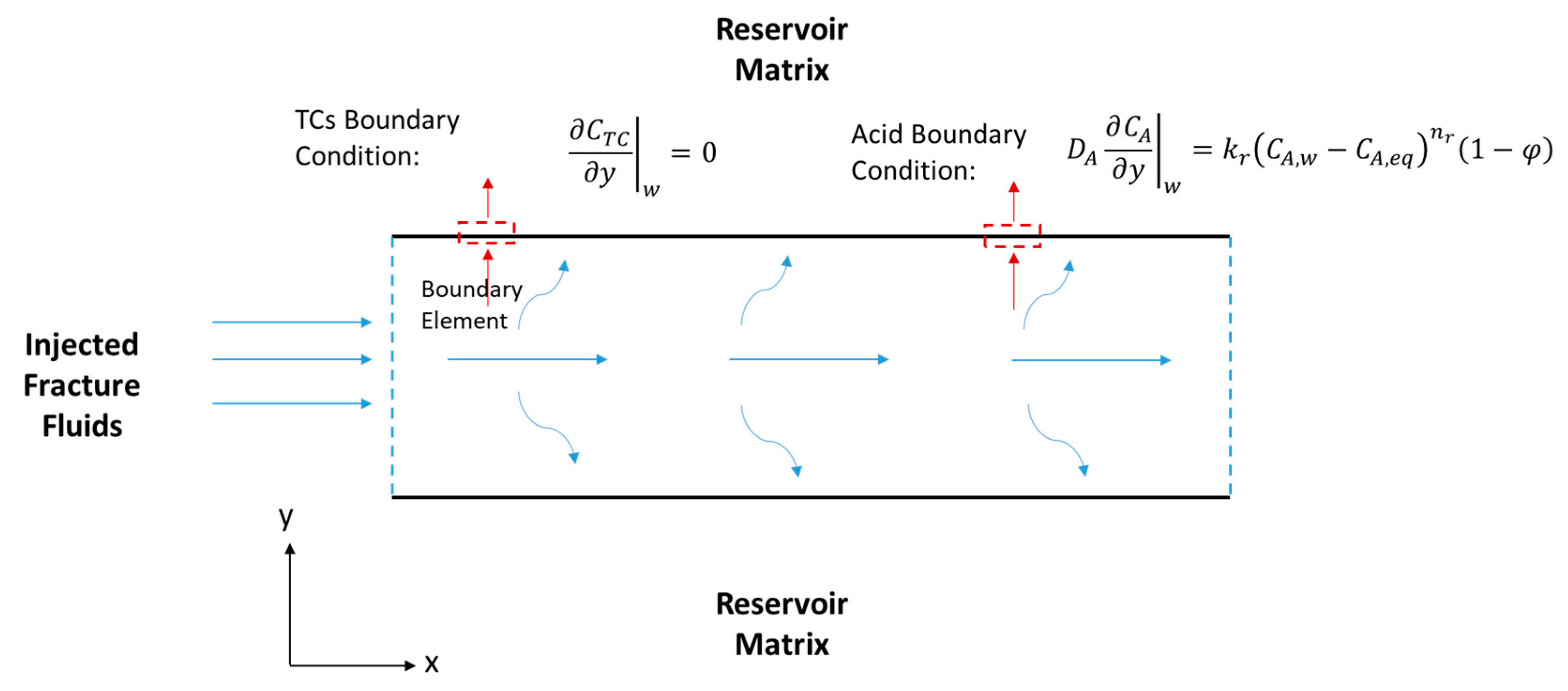
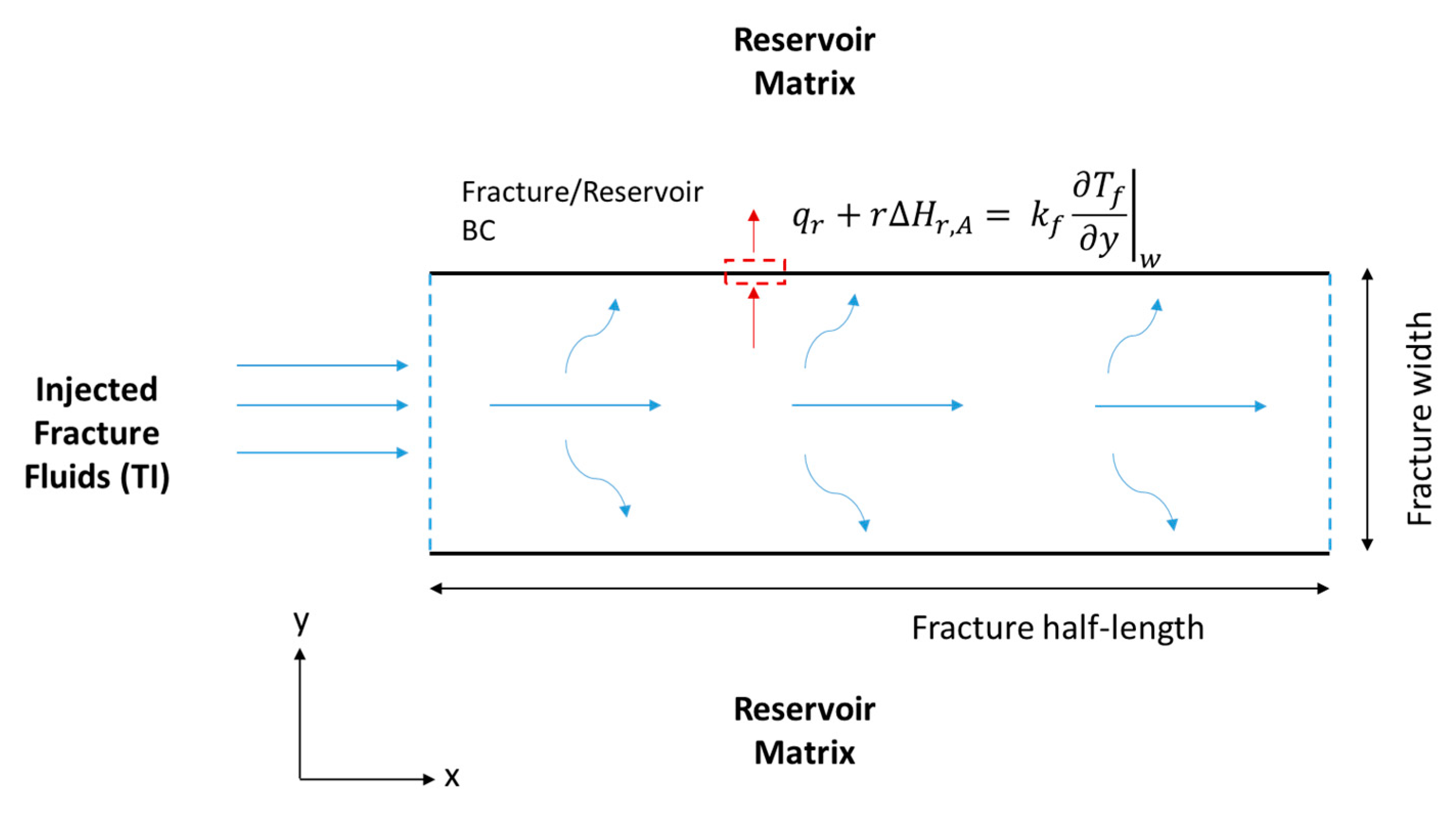
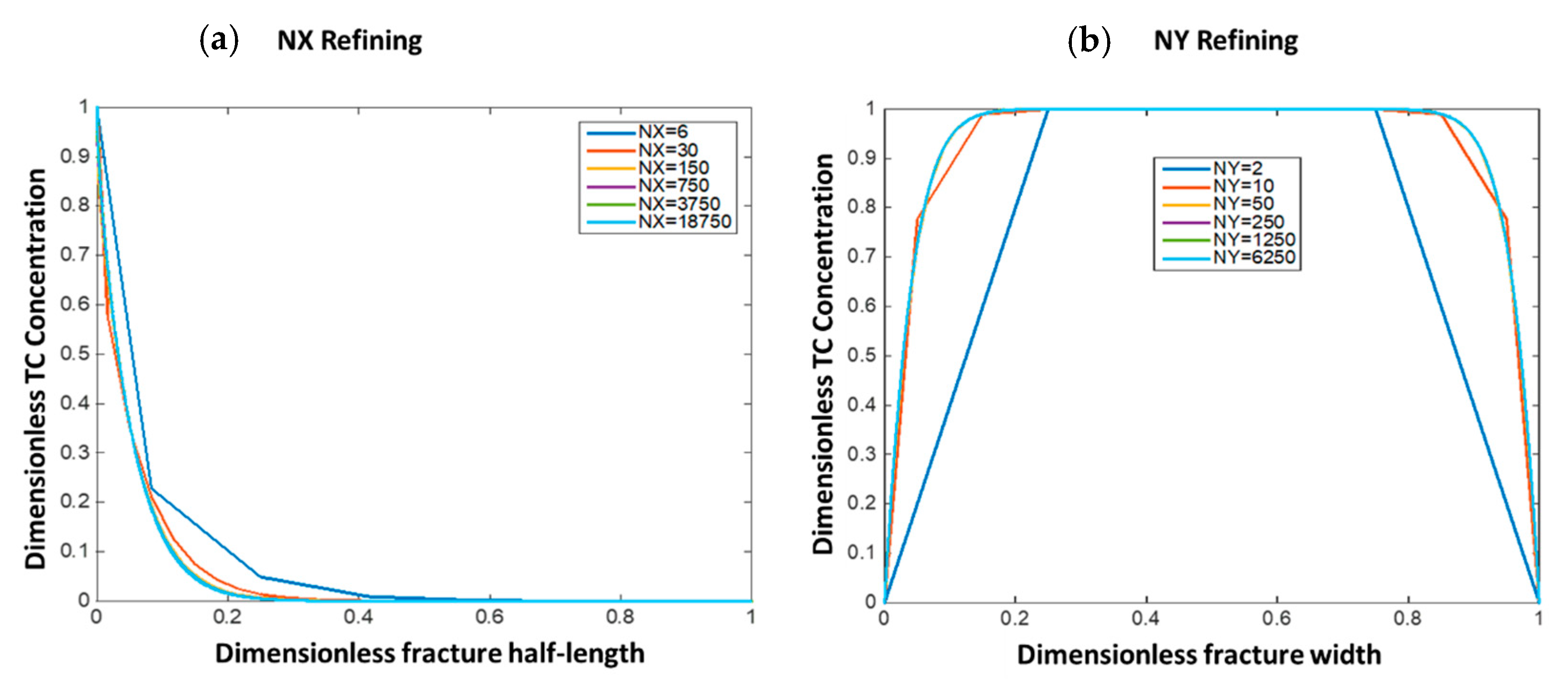
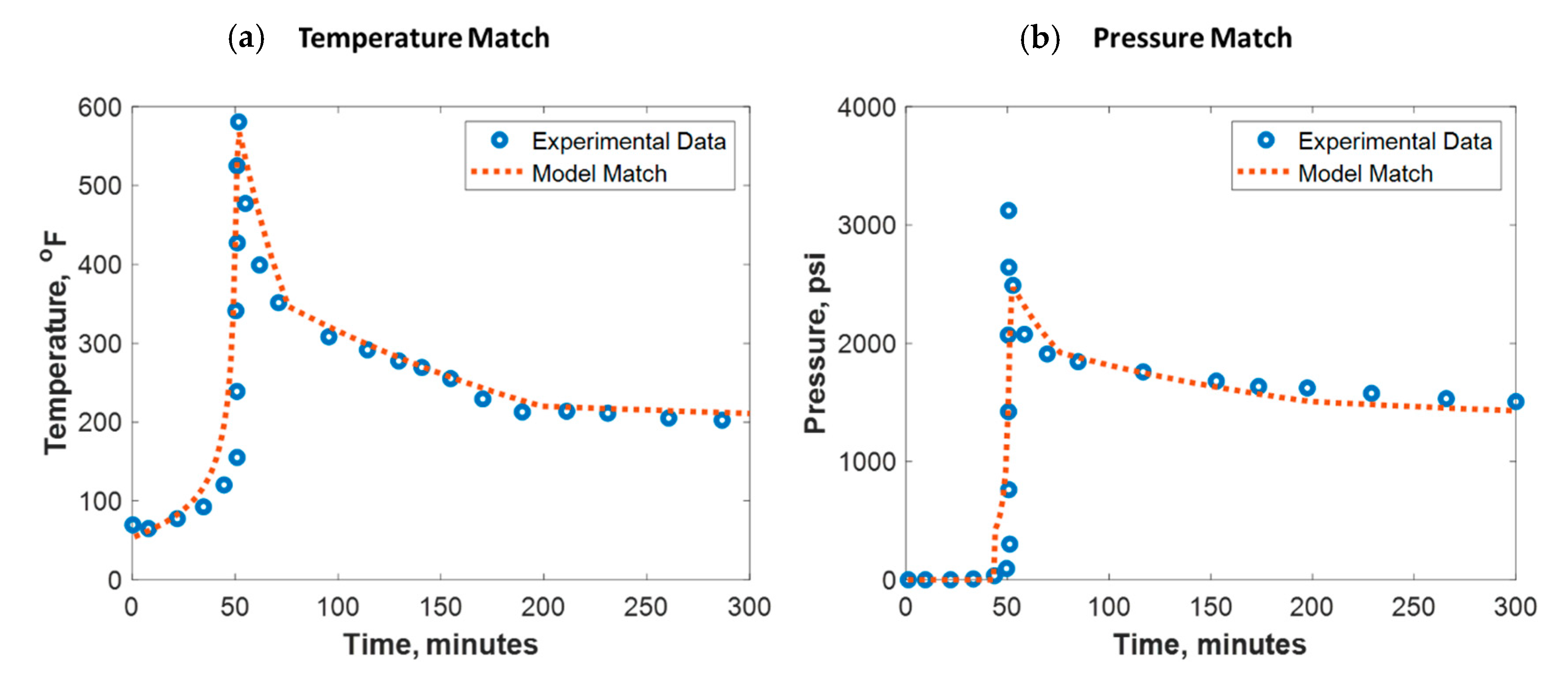
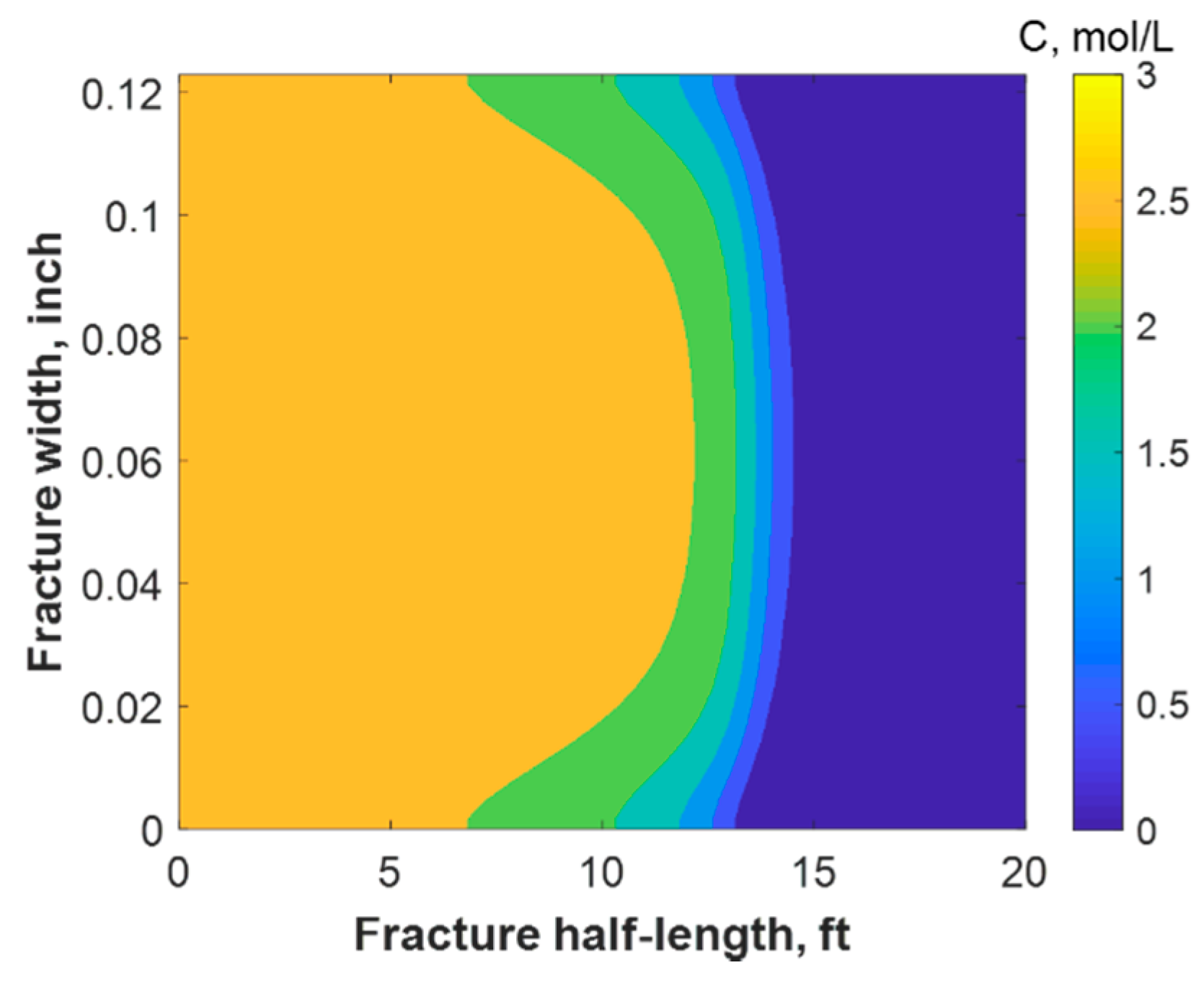
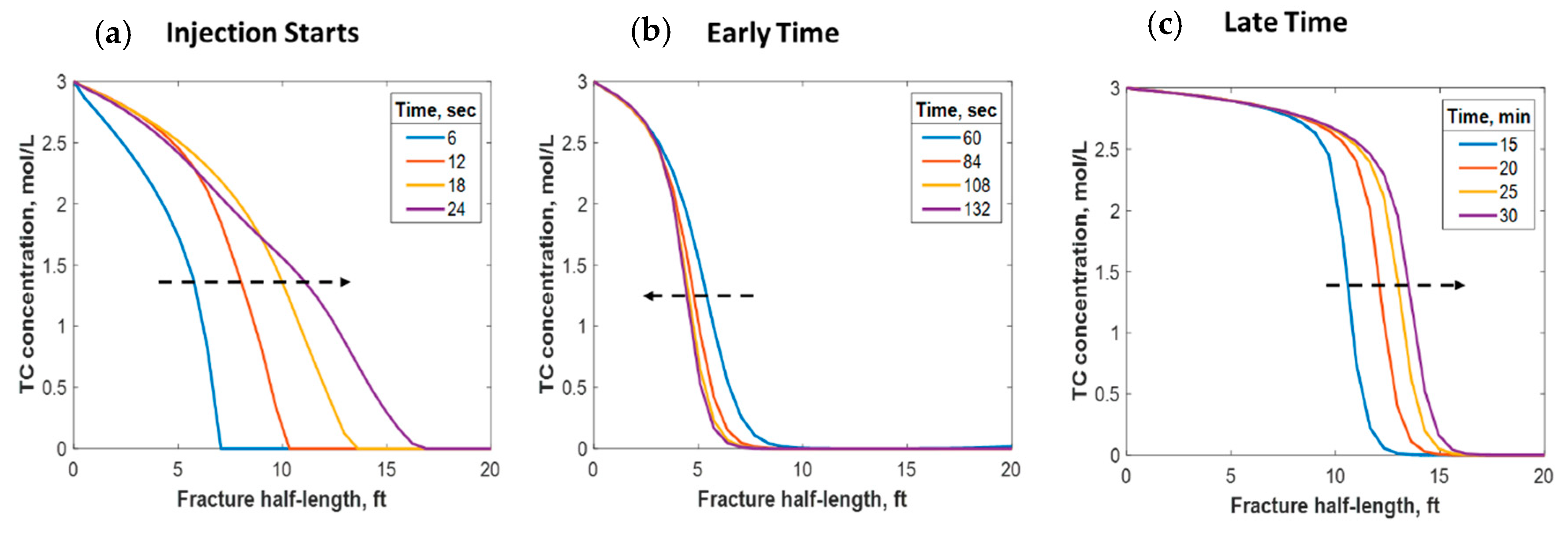
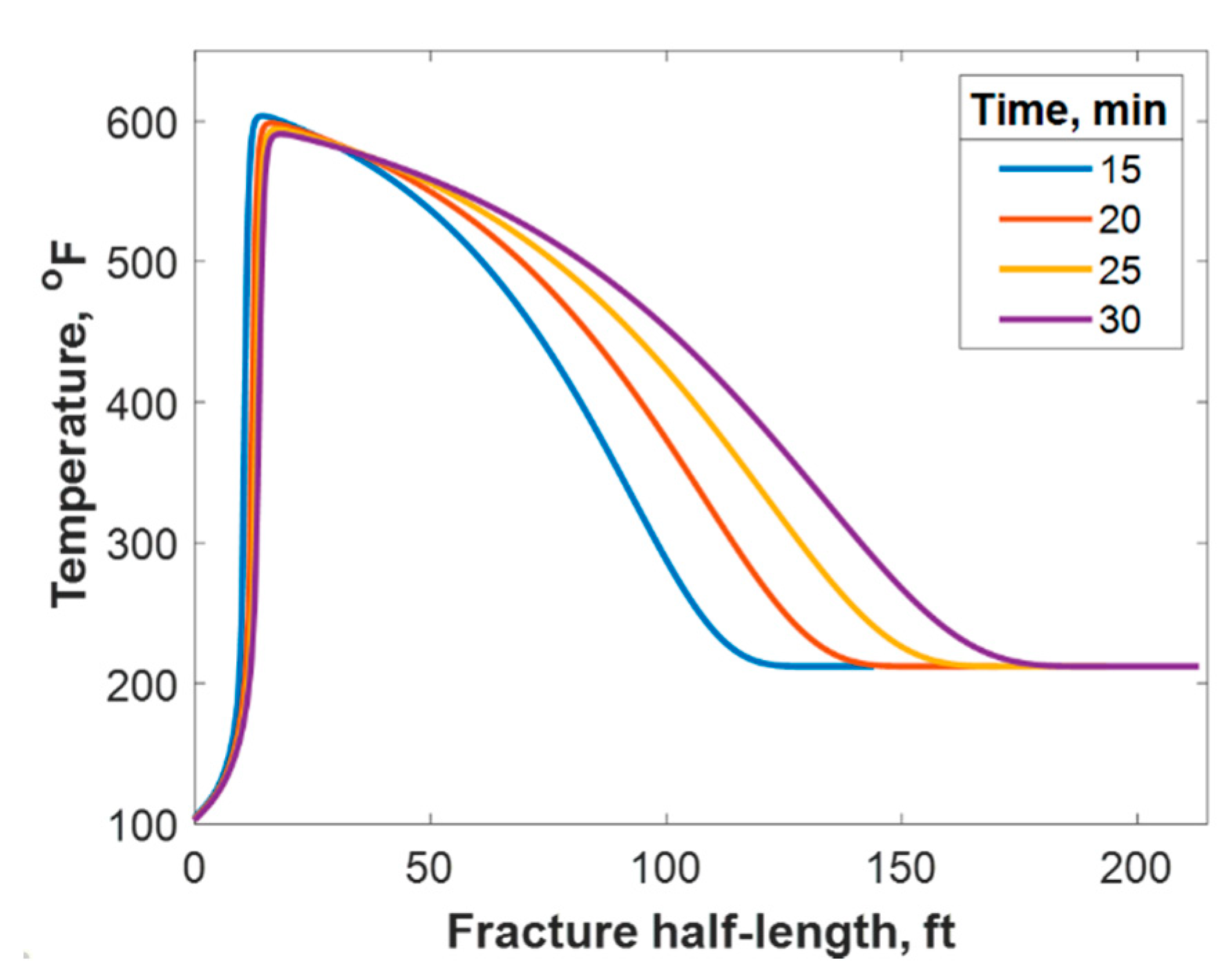



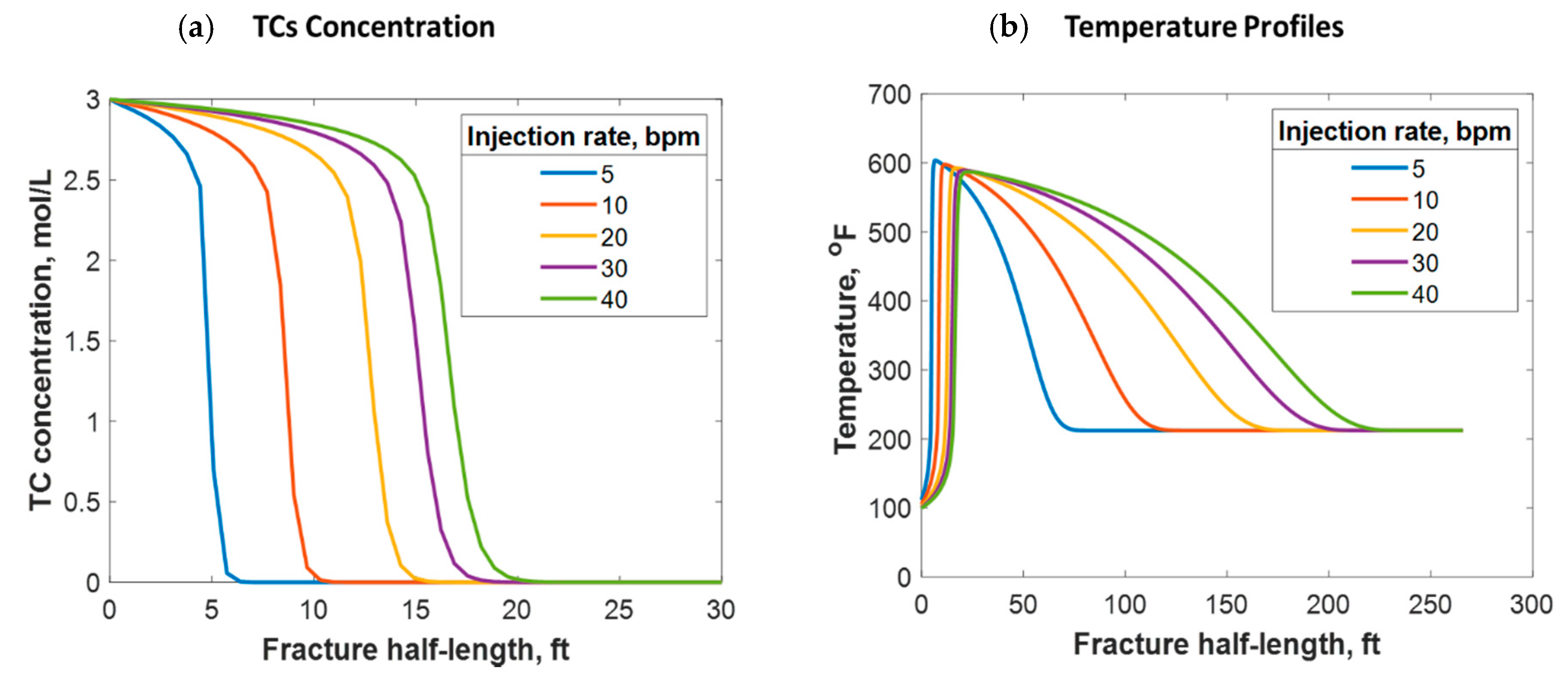



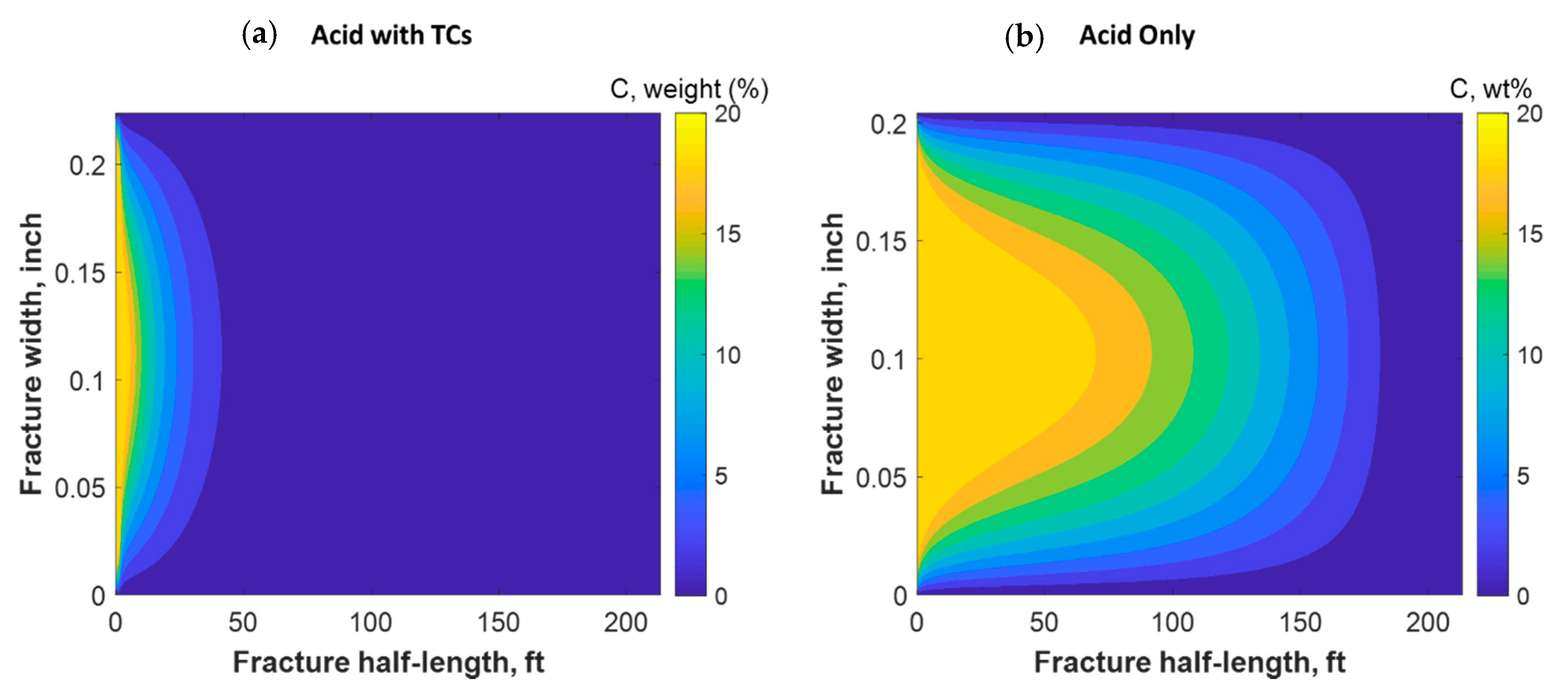

| Input Data | SI Unit | Field Unit |
|---|---|---|
| Wellbore Property | ||
| Inner casing radius, | 0.0628 m | 2.475 inch |
| Overall heat transfer coefficient, | 0.1 KJ/(s·m2 °C) | 0.0048 Btu/(hr·ft2 °F) |
| Ambient temperature, | 25 °C | 77 °F |
| Reservoir/Formation Property | ||
| Reservoir pressure, | 2.0684 × 107 pa | 3000 psi |
| Formation fluid density, | 850 Kg/m3 | 54 lbm/ft3 |
| Formation fluid viscosity, | 0.0008 Kg/(m·s) | 0.8 cp |
| Tal compressibility, | 2.26 × 10−9 pa−1 | 1.56 × 10−5 psi−1 |
| Reservoir temperature, | 100 °C | 212 °F |
| Formation rock density, | 2700 Kg/m3 | 168.5 lbm/ft3 |
| Formation thickness, | 100 ft | 30.5 m |
| Formation specific heat capacity, | 0.879 KJ/(Kg °C) | 0.2099 Btu/(lb. °F) |
| Formation thermal conductivity, | 1.57 × 10−3 KJ/(s·m °C) | 0.907 Btu/(hr·ft °F) |
| Young’s modulus, | 3.1 × 109 pa | 4.5 × 106 psi |
| Closure stress, | 3.45 × 107 pa | 5000 psi |
| Poisson’s ratio, | 0.25 | |
| Fluid Property | ||
| Density, | 1070 Kg/m3 | 66.8 lbm/ft3 |
| Opening time distribution factor, | 1.5 | |
| Acid initial concentration, | 0.20 mass HCl/mass solution | |
| Diffusion coefficient, | 5 × 10−5 cm2/s | |
| Fluid specific heat capacity, | 4.13 KJ/(Kg °C) | 0.964 Btu/(lbm °F) |
| Power law exponent, | 0.9 | |
| Consistency index, | 0.002 lbf.sn/ft2 | |
| Fluid loss coefficient, | 0.004 ft/min0.5 | |
| Fluid thermal conductivity, | 6 × 10−4 KJ/(s·m °C) | 0.347 Btu/(hr·ft °F) |
| Fluid temperature at injection, | 35 °C | 95 °F |
© 2020 by the authors. Licensee MDPI, Basel, Switzerland. This article is an open access article distributed under the terms and conditions of the Creative Commons Attribution (CC BY) license (http://creativecommons.org/licenses/by/4.0/).
Share and Cite
Aljawad, M.S.; Mahmoud, M.; Abu-Khamsin, S.A. Mass and Heat Transfer of Thermochemical Fluids in a Fractured Porous Medium. Molecules 2020, 25, 4179. https://doi.org/10.3390/molecules25184179
Aljawad MS, Mahmoud M, Abu-Khamsin SA. Mass and Heat Transfer of Thermochemical Fluids in a Fractured Porous Medium. Molecules. 2020; 25(18):4179. https://doi.org/10.3390/molecules25184179
Chicago/Turabian StyleAljawad, Murtada Saleh, Mohamed Mahmoud, and Sidqi A Abu-Khamsin. 2020. "Mass and Heat Transfer of Thermochemical Fluids in a Fractured Porous Medium" Molecules 25, no. 18: 4179. https://doi.org/10.3390/molecules25184179
APA StyleAljawad, M. S., Mahmoud, M., & Abu-Khamsin, S. A. (2020). Mass and Heat Transfer of Thermochemical Fluids in a Fractured Porous Medium. Molecules, 25(18), 4179. https://doi.org/10.3390/molecules25184179








